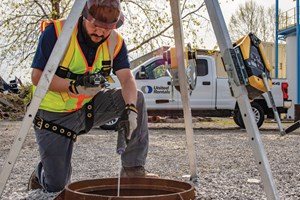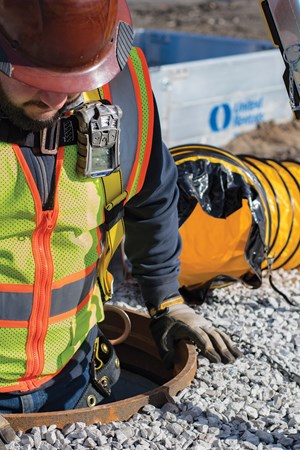March 2020 Vol. 75 No. 3
Features
Working in Confined Spaces: Be Safe, Not Sorry
By Bruce Magee
In construction and industry, some potential hazards are visibly manifest, such as the risk of falls from heights. Others are more hidden. A confined space may not look dangerous, but workers perish each year because someone assumed the air inside was safe to breathe, when testing would have revealed that it wasn’t.
In 2017, 166 workers died in incidents involving confined spaces, a 15-percent increase from the previous year, according to the Bureau of Labor Statistics.
The real tragedy is that such fatalities are potentially preventable by understanding and following OSHA requirements for entering confined spaces. But significant confusion remains around which of the two confined space standards to follow, and that confusion can result in all-too-common noncompliance.
Tale of Two Standards
OSHA introduced the confined space standard for general industry (1910.146) first. It was intended for static environments, not agriculture, construction or shipyard work. In 2015, OSHA introduced the Confined Spaces in Construction standard (1926.1203) to guard against the unique hazards of confined space operations in dynamic environments.
The new standard caused some confusion, and enforcement was deferred to 2016. Part of the confusion stemmed from the many references to home construction in a related “Frequently Asked Questions”document, which led some people in industry to think the standard did not apply to construction activities in plants.
It does. It also applies to companies that are repairing an existing facility or replacing structures and their components, or performing a large, complex maintenance project. Maintenance work that does not involve new equipment or structures is covered under the General Industry standard.
The Confined Spaces in Construction standard doesn’t apply to excavations, which are regulated by §1926 subpart P – Excavations, except when workers have to enter a confined space (such as a pipe) within the excavation. In that case, instead of following the Excavation standard when measuring the atmosphere for levels of oxygen and flammable gasses, the contractor must follow the mor- stringent Confined Spaces in Construction standard.
Other points of confusion
Companies often fail to follow two other provisions of the new standard. One is the competent person requirement.
The standard requires the presence of a “competent person” onsite if a confined space will be entered. Many employers make the mistake of thinking they can tap any veteran employee for the role, but specialized knowledge is necessary and often that means formal training. The competent person must be able to identify existing and predictable hazards in a confined space and the area around it, be knowledgeable about appropriate testing, and be able to conduct initial testing as necessary. He or she needs to know the maximum levels for each type of gas. In addition, the designated person must have the authority to take prompt, corrective action to eliminate any hazards that are found.
The other, often-overlooked provision is the top-down reporting requirement. The employer that owns or manages the property where the construction work is taking place is required to share any information it has about the hazards in the confined space with the general contractor. Also, the general contractor must pass this information down to any subcontractors doing work in the space. This requirement ensures that those who enter the space know the hazards they may face and can prepare for them. When the entrants have exited the space, the findings must be reported back up to the owner so that any new issues may be documented for the next entry.
Cost of noncompliance
Companies that fail to comply with the appropriate standard could be subject to citations and fines, which can impact their reputations, their insurance premiums and their bottom line. Of course, the real price to pay is the potential loss of life.
Company executives should familiarize themselves with both confined-space standards and know when each applies, rather than turn the keys over to their safety directors and hope for the best. Safety directors should understand both standards and what they require. And they should ensure that all field personnel assigned the role of competent person receive the training needed to live up to the title.
Contractors doing things like opening a manhole on a job site and using their noses to evaluate the air is not effective. In fact, simply opening the entrance cover to a confined space may be dangerous if there’s chance a hazardous gas could escape (in which case, workers may need to insert a measuring device before opening the cover).
Fatalities don’t happen when you expect them; they happen when you don’t. The bottom line: rather than assume an atmosphere is harmless, assume it isn’t. Testing is the only way to know for sure. •
Bruce Magee is region product development manager for United Rentals. With 39 years in the rental industry and the last 25 years in trench safety, he has delivered more than 380 Competent Person classes. He has presented on trench safety/confined space safety requirements at more than 100 engineering conferences, and trained construction safety professionals and OSHA compliance officers across North America.






Comments